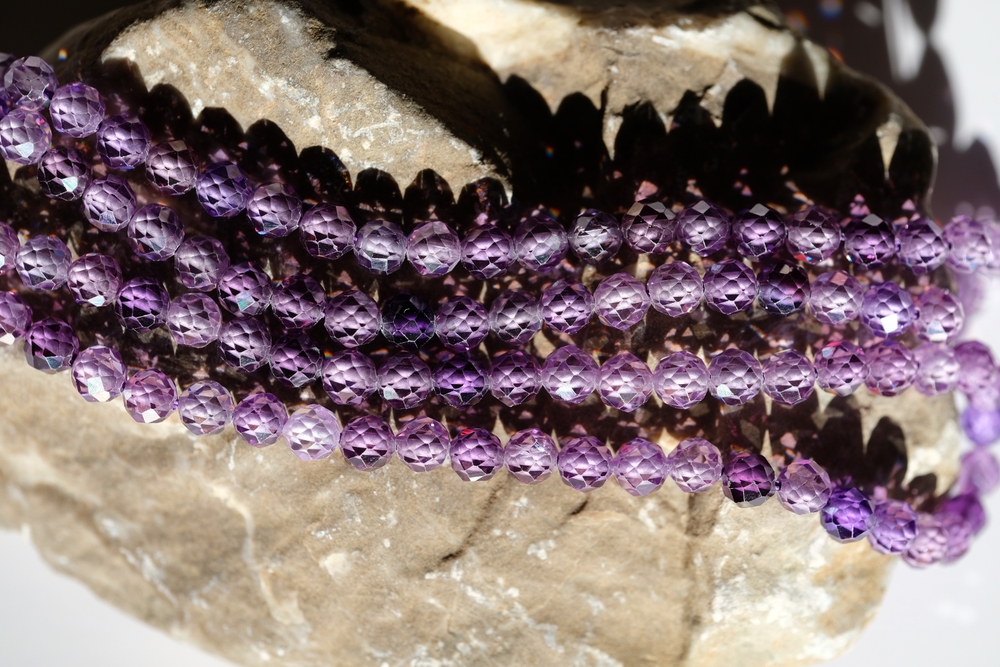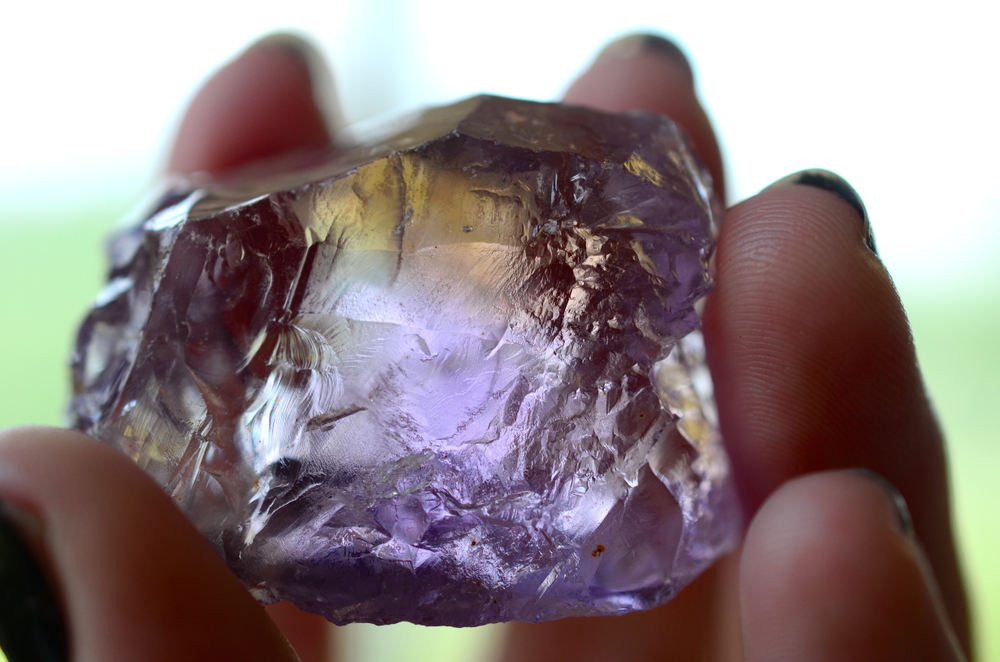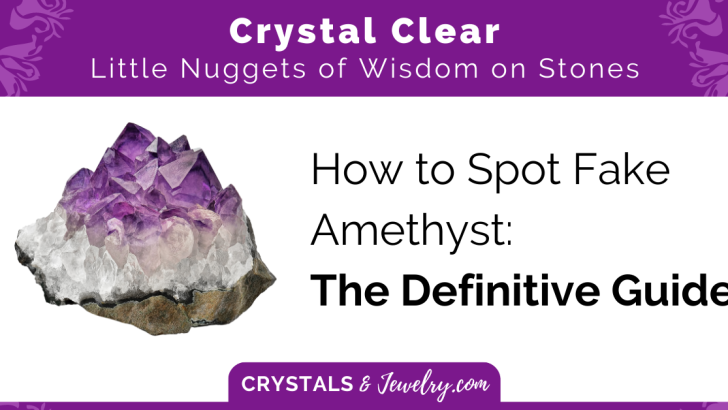Amethyst has been a beloved gemstone for centuries due to its captivating purple hues. Unfortunately, fraudulent activities in the gemstone industry are commonplace; fake stones often pass off as genuine, making it difficult for buyers to differentiate between them.
With this comprehensive guide, we will help you identify real and fake Amethyst so you can make an informed decision when shopping for gemstones.
If you want to learn more about Amethyst, please visit our massive, in-depth guide here.
Understanding Amethyst Properties
Amethyst is a violet to purple variety of Quartz that’s commonly used in jewelry and other decorative objects. Its vibrant hue comes from iron and manganese impurities within the crystal structure.
Amethyst is a mineral with a Mohs hardness of 7, making it relatively tough and durable. It forms in hexagonal prismatic crystal systems, giving off hexagonal prismatic shapes with pointed ends. The most common crystal habit for amethyst occurs as six-sided pyramids with flat tops.
Amethyst is a type of quartz, meaning its chemical composition consists largely of silicon dioxide (SiO2). However, impurities like iron and manganese may alter its physical and optical characteristics such as color and transparency.
Overall, being aware of the physical and chemical characteristics of Amethyst can help us distinguish it from other gemstones and appreciate its distinct beauty and qualities.
Examining Color
Examining the color of an Amethyst is essential in determining its authenticity.
Genuine Amethysts typically exhibit a deep, saturated purple hue that’s neither too light or dark due to trace elements like iron.
On the other hand, fake Amethysts may have similar hues due to dyeing or other treatments; natural color variations like zoning or banding are difficult to replicate in fakes, making their absence or absence an alarming indicator.
To correctly identify Amethysts, one must have an understanding of the various varieties and colors they come in. For instance, Amethysts from Zambia may appear slightly different than those from Brazil or Uruguay.
Furthermore, viewing a stone under various lighting conditions, such as natural daylight or ultraviolet light, can give further clues to its authenticity.
According to the International Colored Gemstone Association, color is “the most critical factor” when assessing an amethyst’s value. Therefore, it is essential to pay close attention to its hue when assessing its authenticity.
Testing Hardness
Testing an Amethyst’s hardness is a reliable way to determine its authenticity.
Amethyst, which is made up of Quartz with a Mohs hardness rating of 7, is relatively hard and durable. With your fingernail, knife blade, or piece of Quartz, gently scratch away at the surface. If the stone is genuine, there should be no scratches or signs of damage present.
According to the Gemological Institute of America, “the hardness of a mineral is an indicator of its resistance to scratching.” Testing an Amethyst’s hardness can determine its authenticity; fake stones tend to be made out of softer materials like glass or synthetic resin that are more vulnerable to scratches or damage.
Keep in mind, that an Amethysts’ hardness may vary depending on its origin and formation conditions. Accurately assessing an Amethyst’s authenticity based on its hardness requires understanding its physical and chemical characteristics.
By testing the hardness of an Amethyst, you can guarantee it’s genuine. Be wary when purchasing gemstones online – only purchase from reliable dealers who will provide a certificate of authenticity.
Checking for Inclusions
Checking for inclusions is a crucial step in determining the authenticity of an Amethyst.
Inclusions refer to natural imperfections found within gemstones, such as tiny crystals or gas bubbles. Genuine Amethysts usually have inclusions which can be used as proof of their genuineness; reproducing these features in fake Amethysts is difficult so if your stone lacks any, it’s likely to be a fake.
Amethysts contain a range of inclusions, varying in size, shape and location within the stone. To detect them, it’s necessary to examine it under a microscope or magnifying lens. One common inclusion found within Amethysts are “tiger stripes,” or thin parallel lines caused by growth patterns within the crystal.
It’s worth noting that not all inclusions in amethysts are desirable or add value to the stone. Some can affect durability or appearance of the gemstone and decrease its worth.
Overall, checking for inclusions is a critical step in determining the authenticity of an Amethyst. Genuine Amethysts typically possess natural imperfections that are difficult to duplicate in imitation stones, making their presence an indication of genuineness.
Examining the Cut
When assessing an Amethyst’s authenticity, its cut should be taken into account.
Genuine Amethysts typically feature precise cuts with well-defined edges and corners to show off their vibrant color and clarity, adding to their overall beauty.
Fake Amethysts often feature poorly defined or uneven facets and/or be cut into shapes that differ from authentic Amethysts. Since these gems are typically mass-produced, they lack the precision and attention to detail found in genuine Amethysts.
When cutting an Amethyst, it’s essential to consider its shape, proportions and symmetry. A well-cut Amethyst will have an even distribution of light which magnifies its brilliance and sparkle. Furthermore, all facets should be uniform in size and shape for a unified visual impact.
It’s worth noting that the cut of an Amethyst can also influence its value. A well-cut Amethyst with excellent color and clarity will be more desirable than one cut poorly, even if they are both of similar size and weight.
Inspecting an Amethyst’s cut is an essential step in determining its authenticity. Genuine Amethysts are usually cut with precision and attention to detail, showcasing their unique color and enhancing their overall beauty. If the stone has poorly defined or uneven facets or is cut into shapes that differ from authentic Amethysts, it could potentially be a fake.
Ultraviolet Light
Ultraviolet light can be an effective tool in identifying genuine Amethysts.
Genuine Amethysts with high iron content may appear slightly fluorescent with a reddish glow when exposed to UV light; however, it should be noted that not all genuine Amethysts will fluoresce, making this test not always reliable.
Amethysts’ UV fluorescence is caused by iron in their crystal. However, other factors like heat treatment or irradiation can also affect their fluorescence, so it’s essential to use caution when using UV light to identify them and combine it with other tests in order to make an accurate assessment of a stone’s authenticity.
UV light can be a useful tool in identifying genuine Amethysts, but it’s not always accurate. Other factors like color, clarity, inclusions and the cut should all be taken into account when evaluating its authenticity.
Conducting Density Tests
Density tests are another useful method in recognizing fake Amethysts.
Genuine Amethysts usually have a density of around 2.65 grams per cubic centimeter, making them relatively heavy for their size due to the crystal structure and presence of trace elements like iron and manganese.
Conducting a density test using either a gemological balance or special gravity kit is the best way to gauge the stone’s density. If the measured value differs significantly from the expected value of 2.65 grams per cubic centimeter, this could indicate that the stone is an imitation.
It’s essential to note that density tests are not always reliable, as some fake Amethysts can be made to match the expected density of genuine stones. Furthermore, other factors like heat treatment or irradiation can affect an Amethyst’s density, making it harder to differentiate between genuine and fake stones.
Although density testing can be an effective tool in detecting fake Amethysts, it should be combined with other tests such as color, inclusions and cut to make an accurate assessment of a stone’s authenticity.
Are You Unsure about the Authenticity of Your Amethyst?
If you’re uncertain of the authenticity of your Amethyst, consulting a certified gemologist or jeweler is recommended.
These professionals possess specialized equipment and knowledge that can accurately determine if the stone is real or fake, plus they provide certificates of authenticity if needed.
Certified gemologists and jewelers can utilize various techniques to verify the authenticity of an Amethyst, such as performing a density test, inspecting it under a microscope, checking for fluorescence with UV light, assessing color, cut, and clarity to determine its authenticity.
When purchasing Amethyst, it’s essential to select a reliable and experienced gemologist or jeweler for evaluation. Their knowledge and equipment can help determine the stone’s authenticity, giving you peace of mind in your purchase.
When buying an Amethyst, be sure to request its certificate of authenticity from an established source to guarantee its quality and authenticity.
Overall, seeking professional assistance from a certified gemologist or jeweler is the wisest course of action if you’re uncertain about the authenticity of your Amethyst.
Their specialized knowledge and equipment can enable you to make an informed decision regarding your stone’s authenticity.
Common Types of Fake Amethysts
Fake Amethysts come in many forms, such as glass, cubic zirconia, synthetic Quartz, and dyed stones.
Glass imitations tend to be easy to spot due to their lack of physical and chemical characteristics like real amethysts; they may appear too perfect or uniform with no natural variations in color, inclusions, or overall appearance.

Cubic zirconia is a widely-used imitation for gemstones, including Amethyst. With similar hardness and refractive index as real Amethyst, it may be difficult to tell them apart at first glance. However, upon closer examination you’ll often notice that cubic zirconia lacks natural inclusions and color zoning found in genuine Amethyst.

Fake Amethyst can also be made out of synthetic quartz (known as Ametrine). Although this stone appears similar to real Amethyst, it has a distinct crystal structure and physical characteristics. Synthetic quartz is typically created in a laboratory and easily identified by its consistent color and lack of natural inclusions.
Dyed stones are popular imitations of Amethysts. Generally, these stones are made from lower-grade materials like Agate or Quartz and then dyed to achieve the desired hue. Over time though, the dye may fade or wear off, revealing the true color and quality of the stone beneath.
It is essential to be aware of the common types of fake amethysts and conduct the necessary tests in order to verify their authenticity. Consulting a certified gemologist or jeweler can also give you peace of mind when purchasing Amethysts.
Conclusion
Identification of real and fake Amethysts can be tricky. But with proper evaluation of color, hardness, inclusions, cut, fluorescence and density – plus professional help when buying online – you can ensure what you paid for.
It’s essential to be cautious when purchasing gemstones online; only purchase from trusted dealers who issue certificates of authenticity.
By following the advice provided in this comprehensive guide and taking necessary precautions, you can protect yourself from falling victim to fraudsters and guarantee your Amethyst is authentic.
Genuine Amethysts are rare and valuable gemstones; so it pays off to take extra time and effort to guarantee you get what you pay for.
With this knowledge at your disposal, you can make an informed decision and purchase a beautiful genuine amethyst that you will cherish for years to come.
Frequently Asked Questions
Common methods include heating, dyeing, coating and synthetic manufacturing.
To determine whether your gemstone is genuine or not, you can perform several tests such as checking its color consistency, inspecting its transparency, and using a UV light.
No, fake Amethyst has no intrinsic value as it is not a genuine gemstone. Therefore, it is important to verify the authenticity of your Amethyst before spending money on it and guarantee you get exactly what you paid for.
Yes, you can distinguish natural from synthetic amethyst by looking at factors such as color, clarity and internal characteristics of the stone.
To detect dyeing in Amethyst, you can use a magnifying glass to inspect its surface for uneven color distribution or traces of dye.
Synthetic Amethyst is created in a laboratory without natural origin, while natural Amethyst forms through geological processes and is mined from beneath the earth.
Yes. Amethyst’s color can be enhanced through heating or irradiation to achieve a deeper hue. Before purchasing, be sure to confirm if your Amethyst has undergone any treatments.
Yes, several gems can be mistaken for Amethyst, such as purple fluorite, purple topaz and purple sapphire.
Amethyst is believed to have many metaphysical properties, such as promoting calmness and clarity, sharpening intuition, and shielding against negative energy.
To guarantee you get a genuine stone, purchase from a reliable dealer and verify its authenticity through certification or testing.
Diana Houston
Diana Houston is a respected crystal expert and the author of 'A Beginner's Guide to Healing Crystals: Getting Started With Crystal Healing – A Complete Guide.' Her passion for crystals and their healing properties made her a leading authority on the subject.
Diana's expertise and passion for crystals have inspired countless readers and practitioners, and her book has received rave reviews on Amazon. With her clear and insightful guidance, Diana is a trusted guide for anyone seeking to unlock the transformative power of crystals.
Available on Amazon!

